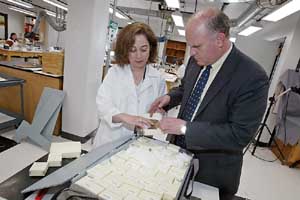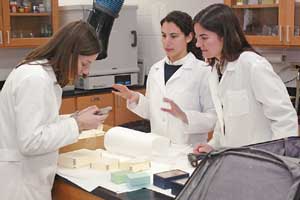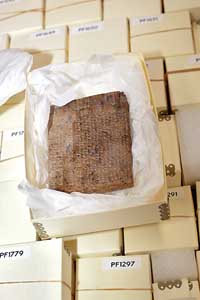Oriental Institute returns ancient tablets that explain an empire’s administrative life
By William HarmsNews Office
 Laura D’Alessandro, museum conservator at the Oriental Institute (left), looks over the tablet fragments with Gil Stein, Director of the Oriental Institute, before their trip to Iran.  Vanessa Muros, Sarah Barack and Alison Whyte pack the tablets for shipment.  | |
The Oriental Institute returned a set of 300 ancient Iranian tablets to the Iranian Cultural Heritage Organization last week in the first return of loaned archaeological items since the 1979 revolution in Iran. The tablets, which provide details of the inner workings of the administration of the ancient Persian Empire, are among a group of tens of thousands of tablets and tablet fragments that were loaned to the University’s Oriental Institute in 1937.
The tablets were warmly received in a ceremony in Tehran attended by officials from the ICHO, as well as representatives of a number of ministries and the prime minister and president’s offices.
At the ceremony, Gil Stein, Director of the Oriental Institute, said, “It is a great privilege for us to return the tablets to their home. We plan on continuing returning more tablets. We are very fortunate to be able to work as partners with Iranian scholars in creating a framework between the Oriental Institute and ICHO.”
Mohammad Beheshti, head of the ICHO, said, “Even though this material is part of the Iranian cultural heritage, it also is part of the world cultural heritage.” He welcomed the cooperation between the two institutions.
Laura D’Alessandro, museum conservator and a member of the delegation, oversaw the careful packing of the tablets and presented a workshop on conservation to colleagues in Tehran as part of the visit.
The 300 returned tablets, which are made of clay and impressed in cuneiform, record administrative details of the Persian heartland from about 500 B.C. A group of 179 complete tablets was returned in 1948, and another group of more than 37,000 tablet fragments was returned in 1951.
As information about the Persian Empire had been largely limited to non-Persian sources, the tablets have been difficult to read. That non-Persian information came from Greek writers such as Herodotus and Latin authors, and mostly concerns encounters of warfare and diplomacy between the Persian Empire and Greek states. Information from the tablets provided one of the first opportunities to gather data on the empire from Persian sources.
“The Persian Empire was the largest and most durable empire of its time. The empire stretched from Ethiopia, through Egypt, to Greece, to Anatolia (modern Turkey), Central Asia and to India,” said Matthew Stolper, the John A. Wilson Professor in the Oriental Institute and an expert on ancient Iran.
In addition to administrative information on the empire and its governance, the texts also contain seal impressions that indicate the existence of some otherwise-unknown administrative offices. The texts identify for the first time leaders of various ranks in the empire and expand on material in other non-Persian texts.
University archaeologists discovered the tablets in 1933 while excavating in Persepolis, the capital of the Persian Empire and the site of a major Oriental Institute excavation.
The tablets document such information as the daily rations of barley given to workers in nearby regions of the empire. “These tablets function much like credit card receipts,” said Charles Jones, Research Associate and Librarian at the Oriental Institute and a tablet expert. “They provide an incredibly rich amount of information.” The basic daily ration for an adult male worker was about one and a half quarts of barley and a half-quart of beer or wine. Many workers received two to five times as much. People of very high political or social status received many times more than that.
Books with the translations and seal impressions on the tablets have been published. The remainder of those texts will be returned at later dates. Digital images also have been produced, which will be shared with the Iranians.
![[Chronicle]](/images/sidebar_header_oct06.gif)